The Arabidopsis peroxisomal targeting signal type 2 receptor PEX7 is necessary for peroxisome function and dependent on PEX5
- PMID: 15548601
- PMCID: PMC545895
- DOI: 10.1091/mbc.e04-05-0422
The Arabidopsis peroxisomal targeting signal type 2 receptor PEX7 is necessary for peroxisome function and dependent on PEX5
Abstract
Plant peroxisomal proteins catalyze key metabolic reactions. Several peroxisome biogenesis PEROXIN (PEX) genes encode proteins acting in the import of targeted proteins necessary for these processes into the peroxisomal matrix. Most peroxisomal matrix proteins bear characterized Peroxisomal Targeting Signals (PTS1 or PTS2), which are bound by the receptors PEX5 or PEX7, respectively, for import into peroxisomes. Here we describe the isolation and characterization of an Arabidopsis peroxin mutant, pex7-1, which displays peroxisome-defective phenotypes including reduced PTS2 protein import. We also demonstrate that the pex5-1 PTS1 receptor mutant, which contains a lesion in a domain conserved among PEX7-binding proteins from various organisms, is defective not in PTS1 protein import, but rather in PTS2 protein import. Combining these mutations in a pex7-1 pex5-1 double mutant abolishes detectable PTS2 protein import and yields seedlings that are entirely sucrose-dependent for establishment, suggesting a severe block in peroxisomal fatty acid beta-oxidation. Adult pex7-1 pex5-1 plants have reduced stature and bear abnormally shaped seeds, few of which are viable. The pex7-1 pex5-1 seedlings that germinate have dramatically fewer lateral roots and often display fused cotyledons, phenotypes associated with reduced auxin response. Thus PTS2-directed peroxisomal import is necessary for normal embryonic development, seedling establishment, and vegetative growth.
Figures
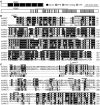
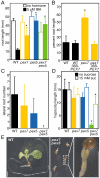

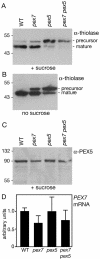
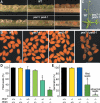

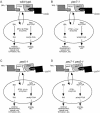
Similar articles
-
Interdependence of the peroxisome-targeting receptors in Arabidopsis thaliana: PEX7 facilitates PEX5 accumulation and import of PTS1 cargo into peroxisomes.Mol Biol Cell. 2010 Apr 1;21(7):1263-71. doi: 10.1091/mbc.e09-08-0672. Epub 2010 Feb 3. Mol Biol Cell. 2010. PMID: 20130089 Free PMC article.
-
pex5 Mutants that differentially disrupt PTS1 and PTS2 peroxisomal matrix protein import in Arabidopsis.Plant Physiol. 2010 Dec;154(4):1602-15. doi: 10.1104/pp.110.162479. Epub 2010 Oct 25. Plant Physiol. 2010. PMID: 20974890 Free PMC article.
-
Peroxisomal ubiquitin-protein ligases peroxin2 and peroxin10 have distinct but synergistic roles in matrix protein import and peroxin5 retrotranslocation in Arabidopsis.Plant Physiol. 2014 Nov;166(3):1329-44. doi: 10.1104/pp.114.247148. Epub 2014 Sep 11. Plant Physiol. 2014. PMID: 25214533 Free PMC article.
-
Structural biology of the import pathways of peroxisomal matrix proteins.Biochim Biophys Acta. 2016 May;1863(5):804-13. doi: 10.1016/j.bbamcr.2015.09.034. Epub 2015 Oct 9. Biochim Biophys Acta. 2016. PMID: 26450166 Review.
-
Getting a camel through the eye of a needle: the import of folded proteins by peroxisomes.Biol Cell. 2010 Feb 12;102(4):245-63. doi: 10.1042/BC20090159. Biol Cell. 2010. PMID: 20146669 Review.
Cited by
-
Identification and functional characterization of Arabidopsis PEROXIN4 and the interacting protein PEROXIN22.Plant Cell. 2005 Dec;17(12):3422-35. doi: 10.1105/tpc.105.035691. Epub 2005 Nov 4. Plant Cell. 2005. PMID: 16272432 Free PMC article.
-
A cargo-centered perspective on the PEX5 receptor-mediated peroxisomal protein import pathway.J Biol Chem. 2013 Oct 4;288(40):29151-9. doi: 10.1074/jbc.M113.487140. Epub 2013 Aug 20. J Biol Chem. 2013. PMID: 23963456 Free PMC article.
-
Elevated growth temperature decreases levels of the PEX5 peroxisome-targeting signal receptor and ameliorates defects of Arabidopsis mutants with an impaired PEX4 ubiquitin-conjugating enzyme.BMC Plant Biol. 2015 Sep 16;15:224. doi: 10.1186/s12870-015-0605-3. BMC Plant Biol. 2015. PMID: 26377801 Free PMC article.
-
Pexophagy and peroxisomal protein turnover in plants.Biochim Biophys Acta. 2016 May;1863(5):999-1005. doi: 10.1016/j.bbamcr.2015.09.005. Epub 2015 Sep 5. Biochim Biophys Acta. 2016. PMID: 26348128 Free PMC article. Review.
-
Proteomic analysis reveals that the Rab GTPase RabE1c is involved in the degradation of the peroxisomal protein receptor PEX7 (peroxin 7).J Biol Chem. 2013 Feb 22;288(8):6014-23. doi: 10.1074/jbc.M112.438143. Epub 2013 Jan 7. J Biol Chem. 2013. PMID: 23297417 Free PMC article.
References
-
- Aida, M., Vernoux, T., Furutani, M., Traas, J., and Tasaka, M. (2002). Roles of PIN-FORMED1 and MONOPTEROS in pattern formation of the apical region of the Arabidopsis embryo. Development 129, 3965-3974. - PubMed
-
- Albertini, M., Rehling, P., Erdmann, R., Girzalsky, W., Kiel, J.A.K.W., Veenhuis, M., and Kunau, W. H. (1997). Pex14p, a peroxisomal membrane protein binding both receptors of the two PTS-dependent import pathways. Cell 89, 83-92. - PubMed
-
- Alonso, J. M. et al. (2003). Genome-wide insertional mutagenesis of Arabidopsis thaliana. Science 301, 653-657. - PubMed
-
- Asamizu, E., Nakamura, Y., Sato, S., and Tabata, S. (2000). A large scale analysis of cDNA in Arabidopsis thaliana: generation of 12,028 non-redundant expressed sequence tags from normalized and size-selected cDNA libraries. DNA Res. 7, 175-180. - PubMed
Publication types
MeSH terms
Substances
LinkOut - more resources
Full Text Sources
Molecular Biology Databases

